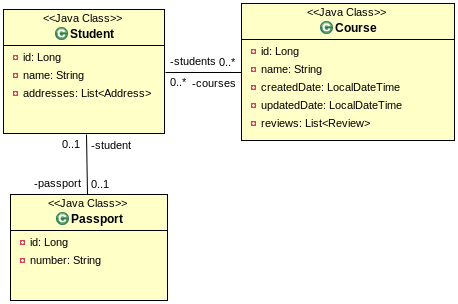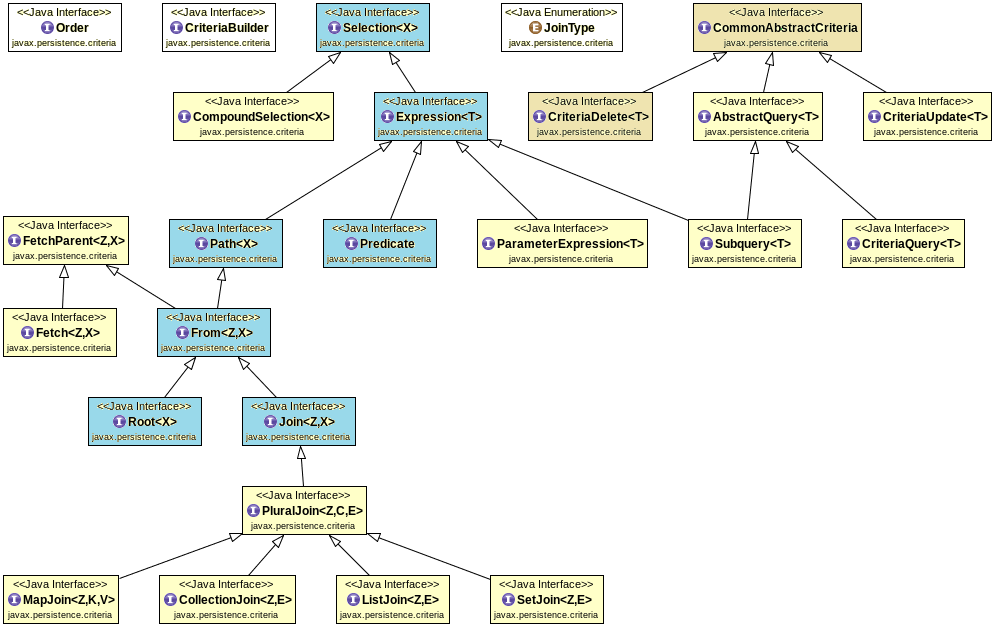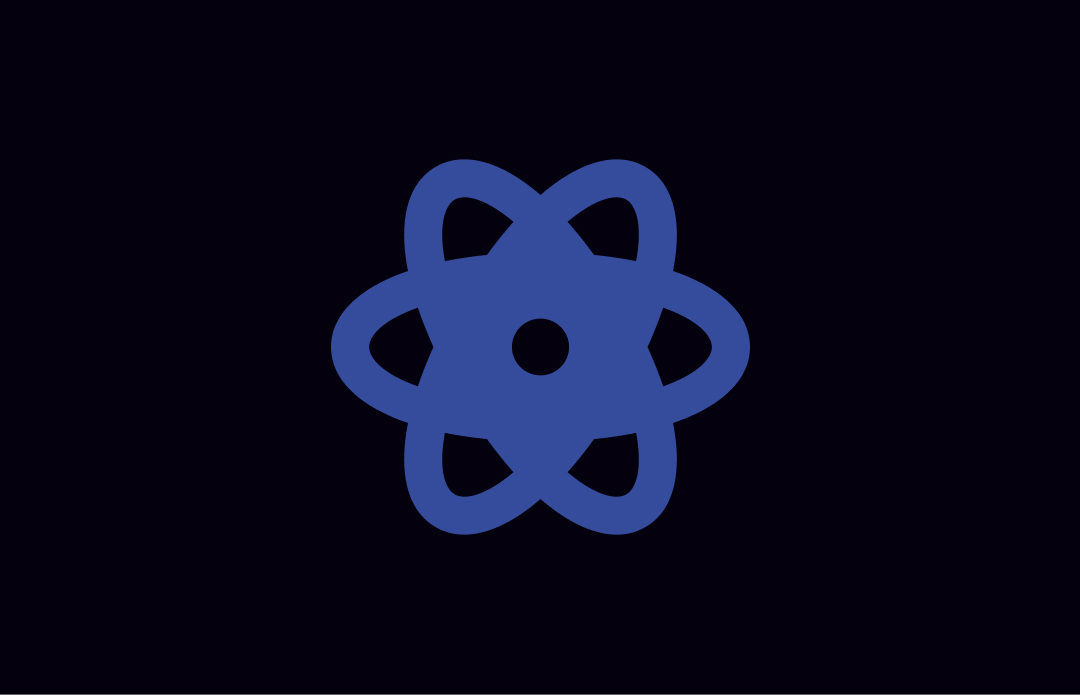Programmatic Criteria Queries using JPA Criteria API
Java Persistence API (JPA) provides the specification of managing data, such as accessing and persisting data, between Java Objects and the databases.
There are obviously many ways in JPA that could be used to interact with a database such as JPQL(Java Persistence Query Language), Criteria API, and Entity specific methods such as persist, merge, remove, flush etc.
I initially found Criteria API quite intimidating. To be frank, I had to invest quite some time to figure it out. It eventually turned out to be quite fluent API. I thought why not just write about the experiences. So here it is, “Creating Programmatic Criteria Queries using JPA Criteria API”.
Criteria Queries are type-safe and portable. They are written using Java programming language APIs. They use the abstract schema of the persistent entities to find, modify and delete persistent entities by invoking JPA Entity Operations.
We will be using the following domain model for building the criteria queries in this tutorial.
 UML diagram describing the Object Relationship Mapping
UML diagram describing the Object Relationship Mapping
We have three Objects( ref. to diagram above ) Student , Course and Passport. Each of the Objects has a relationship with each other:
Studenthas aOne-To-Onerelationship withPassport. It means that Each Student can only have one Passport and vice versa.Studenthas aOne-To-Manyrelationship withAddresswhich means that a Student can have one or more addresses and an address is always assigned to one student.Studenthas aMany-To-Manyrelationship withCoursewhich means that Each Student can enroll in many courses and one course can have many Students enrolled.
We will begin with a simple Criteria Query and slowly try to build upon it.
public Long getStudentsCount() {
/** CriteriaBuilder instance**/
CriteriaBuilder builder = entityManager.getCriteriaBuilder();
/** create a criteriaQuery Object **/
CriteriaQuery<Long> studentQuery = builder.createQuery(Long.class);
/** create a Root Object -> references to the queried entity **/
Root<Student> studentRoot = studentQuery.from(Student.class);
/** Path Object to refer the attribute name of entity **/
/** we are not using it for now **/
Path<Object> namePath = studentRoot.get("name");
/** Aggregate Expression for count operation **/
Expression<Long> countExpression = builder.count(studentRoot);
/** **/
studentQuery.select(countExpression);
/** instance of Typed Query */
TypedQuery<Long> typedStudentQuery =
entityManager.createQuery(studentQuery);
/** return the result **/
Long count = typedStudentQuery.getSingleResult();
return count;
}
The above code example retrieves the total count of students present in the database.
Criteria queries are an Object graph where each part of the graph represents an atomic part of the query. The various steps in building the object graph roughly translates to the following steps.
- A
CriteriaBuilderinterface contains all the required methods to build Criteria Queries, Expressions, Ordering, and Predicates. CriteriaQueryinterface defines functionality required to build a top-level query. The type specified for criteria query i.ecriteriaQuery<Class<T> resultClass>would be the type of the result returned. If no type is provided, the type of result would beObject. Criteria Query contains the methods that specify the item(s) to be returned in the query result, restrict the result based on certain conditions, group results, specify an order for the result and much more.Rootinterface represents the root entities involved in the query. There could be multiple roots defined in the Criteria Query.Pathinterface represents the path to the attribute in therootentity.Pathinterface alsoextendstoExpressionInterface which contains methods that return Predicates.builder.count()is an aggregate method. It returns an expression which would be used forSelectionof the result. When aggregate methods are used as arguments inselectmethod, the type of the query should match the return type of aggregate method.- A
TypedQueryinstance is required to run theCriteriaQuery.
The final output of the above example is below :)
select
count(student0_.id) as col_0_0_
from
student student0_
It seems quite the over work–doesn’t it. The output of so many lines of code is just a plain old SELECT query. But the Criteria API was created to serve a different purpose i.e programmable Query API. It helps to build queries dynamically. You could write just one program to build queries for all objects in your application or build queries depending upon your business logic.
Let’s say, we want to get the count of either Students, Courses or any other entities present in our application. We could either write different queries for each of them or we could only use Criteria API.
public <T> Long getCountOfEntity(Class<T> claz) {
CriteriaBuilder builder = em.getCriteriaBuilder();
CriteriaQuery<Long> studentQuery = builder.createQuery(Long.class);
Root<T> root = studentQuery.from(claz);
Expression<Long> countExpression = builder.count(root);
studentQuery.select(countExpression);
TypedQuery<Long> typedStudentQuery = em.createQuery(studentQuery);
return typedStudentQuery.getSingleResult();
}
I have only updated the previous example to allow the generic parameter which specifies the Class of the Entity. Rest of the Code stays the same. You can learn more about Java Generics here.
Let’s look at the above example in detail.
Criteria Query
CriteriaQuery<T> createQuery(Class<T> resultClass);
CreateQuery method takes the Class name of the result type as an argument.
- If the result is returned as a data-set related to the entity e.g all the students or one of the student. The parameter should be
Student.class.builder.createQuery(Student.class); - If the query returns any other result irrespective of which entity it works on, It should have a parameter of the returned type. As we saw above, when the count was returned, the parameter type was
Long.class
builder.createQuery(Long.class);
Root
Root<T> root = studentQuery.from(Student.Class)
The Root refers to the entity on which the query would be run such as Student.class in the above example.
Select
studentQuery.select(countExpression);
The select method specifies the result to be returned by the Query. If all the attributes of an entity are supposed to be returned instead of just returning the count, we could pass the root entity as the parameter such as below.
studentQuery.select(studentRoot);
Inheritance Relationships
 Interface relationships in Criteria API
Interface relationships in Criteria API
In the Above diagram, observe the classes in a blue background. The relationship tree explains the inheritance hierarchy among various interfaces present in the Criteria API.
Selection is at the top and being extended by Expression. Expression in turn is being extended by Predicate and Path interfaces. From interface extends path which in turn is the parent of both Root and Join Interface.
Root Interface is also an expression. It means, we can query a complete entity by passing Root as a parameter to the select method. In case we want to fetch a selected attribute, we can fetch the attribute path using root.get(attributeName). This method returns a Path object which inherits expression.
Criteria Joins
Implicit Join
root.get("addresses");
When a collection parameter is passed to the get method, it creates a path to corresponding referenced collection-valued attribute. This results in the creation of an INNER JOIN query.
Let’s go back to our domain objects. Student has a OneToMany relationship with Address. To fetch the address, we can use the root.get('address'). Below is an example.
CriteriaBuilder builder = em.getCriteriaBuilder();
CriteriaQuery<Student> cq = builder.createQuery(Student.class);
Root<Student> root = cq.from(Student.class);
cq.select(root.get("addresses"));
em.createQuery(cq).getResultList();
Output Query for the above example looks like as below:
select
addresses1_.id as id1_0_,
addresses1_.city_code as city_cod2_0_,
addresses1_.city_lang as city_lan3_0_,
addresses1_.city_name as city_d nam4_0_,
addresses1_.country as country5_0_,
addresses1_.house_number as house_nu6_0_,
addresses1_.street as street7_0_,
addresses1_.student_id as student_9_0_,
addresses1_.zip_code as zip_code8_0_
from
student student0_
inner join
address addresses1_
on student0_.id=addresses1_.student_id
Note: Since the Address is the Owner of the relationship between Student and Address. By default, the fetch type for a OneToMany relationship is lazy fetch. As a result, there would be extra queries fired to initialize the Student entities related to each Address. However, If we add a where clause and specify a restriction or predicate, it would only result in a Single Query.
Explicit Join
Ideally, when we define relationships in JPA, the Join will be based on the related ID column. However, if we want to define the restriction based on some other column, Join.on(Predicate...) can be used. Join also provides a way to traverse the attributes of the joined entity such as join.get(attributeName).
CriteriaBuilder builder = em.getCriteriaBuilder();
CriteriaQuery<Student> cq = builder.createQuery(Student.class);
Root<Student> root = cq.from(Student.class);
Join<Student, Address> join = root.join("addresses");
/** the below statement is only for the illustration only.
the join relationship will by-default be id and reference id
**/
join.on(builder.equal(root.get("id"), join.get("student")));
cq.multiselect(join);
List<Student> resultList = em.createQuery(cq).getResultList();
The output of the above code example is quite different than what we saw in the implicit join. The initial query only fetches the address id by doing the INNER JOIN. Each of the entities in the relationship is fetched lazily using separate queries
select
addresses1_.id as col_0_0_
from
student student0_
inner join
address addresses1_
on student0_.id=addresses1_.student_id
After all the Id’s are fetched, One query is used to fetch Student and Address details by doing an OUTER JOIN on Student id and address.Student_id.
select
address0_.id as id1_0_0_,
address0_.city_code as city_cod2_0_0_,
address0_.city_lang as city_lan3_0_0_,
address0_.city_name as city_nam4_0_0_,
address0_.country as country5_0_0_,
address0_.house_number as house_nu6_0_0_,
address0_.street as street7_0_0_,
address0_.student_id as student_9_0_0_,
address0_.zip_code as zip_code8_0_0_,
student1_.id as id1_4_1_,
student1_.name as name2_4_1_,
student1_.passport_id as passport3_4_1_
from
address address0_
left outer join
student student1_
on address0_.student_id=student1_.id
where
address0_.id=?
Note: If a restriction is provided in where method of the CritieriaQuery. It would result in a single query.
Fetch Join
FETCH tells the JPA to override the declarative fetch definitions provided through annotation such as @ManyToMany(fetch=FetchType.LAZY) and initialize all the associations or relationships eagerly. As a result, only one query is created.
CriteriaBuilder builder = em.getCriteriaBuilder();
CriteriaQuery<Student> cq = builder.createQuery(Student.class);
Root<Student> root = cq.from(Student.class);
root.fetch("addresses");
cq.select(root);
List<Student> resultList = em.createQuery(cq).getResultList();
The above query output is only a single query as below:
select
student0_.id as id1_4_0_,
addresses1_.id as id1_0_1_,
student0_.name as name2_4_0_,
student0_.passport_id as passport3_4_0_,
addresses1_.city_code as city_cod2_0_1_,
addresses1_.city_lang as city_lan3_0_1_,
addresses1_.city_name as city_nam4_0_1_,
addresses1_.country as country5_0_1_,
addresses1_.house_number as house_nu6_0_1_,
addresses1_.street as street7_0_1_,
addresses1_.student_id as student_9_0_1_,
addresses1_.zip_code as zip_code8_0_1_,
addresses1_.student_id as student_9_0_0__,
addresses1_.id as id1_0_0__
from
student student0_
inner join
address addresses1_
on student0_.id=addresses1_.student_id
Group By and Having clause
Group By Clause is used to group rows with similar values. Having Clause is used to add restrictions for aggregate functions.
GroupBy — method is part of the CriteriaQuery Interface. It either takes one or a List of Expressions as parameters. These expressions are used to form groups over the query results. Below is the signature of the groupBy methods.
/*
* @param grouping zero or more grouping expressions
* @return the modified query
*/
CriteriaQuery<T> groupBy(Expression<?>... grouping);
/*
* @param grouping list of zero or more grouping expressions
* @return the modified query
*/
CriteriaQuery<T> groupBy(List<Expression<?>> grouping);
Having — method is also part of the CriteriaQuery Interface. It either takes a simple or compound boolean Expression or one or more Predicates as parameters. The expression or predicates provided specify the restrictions over the groups of the query. Below is the signature of the having methods.
/**
* @param restriction a simple or compound boolean expression
* @return the modified query
*/
CriteriaQuery<T> having(Expression<Boolean> restriction);
/**
* @param restrictions zero or more restriction predicates
* @return the modified query
*/
CriteriaQuery<T> having(Predicate... restrictions);
To build a Criteria Query which uses the group by and having methods– Let’s assume, we need to fetch all the Students with the number of Addresses greater than or equal to three(3).
CriteriaBuilder builder = em.getCriteriaBuilder();
CriteriaQuery<Student> cq = builder.createQuery(Student.class);
/** Query the address entity **/
Root<Address> root = cq.from(Address.class);
/** join with student to fetch the student_id **/
Join<Address, Student> joinOnStudent = root.join("student");
/** count expression on the address_id **/
Expression<Long> count = builder.count(root.get("id"));
/** fetch students , group by student_id , habving count >= 3 **/
cq.select(joinOnStudent)
.groupBy(joinOnStudent.get("id"))
.having(builder.ge(count, 3));
List<Student> resultList = em.createQuery(cq).getResultList();
The output results in an SQL with an INNER JOIN between Student and Address on Student_id column. It fetches students with restrictions provided by HAVING clause on aggregate function mentioned by Group By clause.
Hibernate:
select
student1_.id as id1_4_,
student1_.name as name2_4_,
student1_.passport_id as passport3_4_
from
address address0_
inner join
student student1_
on address0_.student_id=student1_.id
group by
student1_.id
having
count(address0_.id)>=3
Order By
The order by keyword is used to sort the fetched data either in ascending order or descending order of the value of a column. It can also include aggregate functions.
The Order interface provides the below methods
reverse()method switches the ordering.isAscending()checks whether ascending order is in place.getExpression()fetches the expression that is used for ordering.
The CriteriaBuilder interface provides the following methods to enforce order in a criteria query.
asc(Expression<?> x): this method returns anOrderinstance which enforces an ascending order by the value of the expression provided as the parameter.desc(Expression<?> x): this method returns anOrderinstance which enforces a descending order by the value of the expression provided as the parameter.
Let’s modify the above example to add the descending order such that we have all the students in descending order of the number of addresses.
CriteriaBuilder builder = em.getCriteriaBuilder();
CriteriaQuery<Student> cq = builder.createQuery(Student.class);
Root<Address> root = cq.from(Address.class);
Join<Address, Student> joinOnStudent = root.join("student");
Expression<Long> count = builder.count(root.get("id"));
cq
.select(joinOnStudent)
.groupBy(joinOnStudent.get("id"))
.having(builder.ge(count, 3))
.orderBy(builder.desc(count));
List<Student> resultList = em.createQuery(cq).getResultList();
The output query produced by the above criteria query is below:
select
student1_.id as id1_4_,
student1_.name as name2_4_,
student1_.passport_id as passport3_4_
from
address address0_
inner join
student student1_
on address0_.student_id=student1_.id
group by
student1_.id
having
count(address0_.id)>=3
order by
count(address0_.id) asc
Subquery
A subquery is a nested query which is embedded in the WHERE clause of the main query. The results of the subquery are consumed by the main query.
subquery method is part of CommonAbstractCriteria interface. This interface provides functionality which is common to both top-level criteria queries as well as subqueries.
Let’s change the above example to include a subquery.
CriteriaBuilder builder = em.getCriteriaBuilder();
CriteriaQuery<Student> cq = builder.createQuery(Student.class);
Root<Student> root = cq.from(Student.class);
cq.select(root);
/** Subquery is created from the main criteria query **/
Subquery<Long> subquery = cq.subquery(Long.class);
Root<Address> subRoot = subquery.from(Address.class);
Join<Address, Student> joinOnStudent = subRoot.join("student");
Path<Long> idPath = joinOnStudent.get("id");
Expression<Long> idCountExp = builder.count(subRoot.get("id"));
subquery
.select(idPath)
.groupBy(idPath)
.having(builder.ge(idCountExp, 3));
/** subquery is provided as a parameter to the where method **/
cq.where(root.get("id").in(subquery));
List<Student> resultList = em.createQuery(cq).getResultList();
Below is the output of the final query produced–
select
student0_.id as id1_4_,
student0_.name as name2_4_,
student0_.passport_id as passport3_4_
from
student student0_
where
student0_.id in (
select
student2_.id
from
address address1_
inner join
student student2_
on address1_.student_id=student2_.id
group by
student2_.id
having
count(address1_.id)>=3
)
Aggregate Functions
Criteria API supports the aggregate functions such as count, avg, max, and min etc. All the aggregate functions are part of the CriteriaBuilder Interface.
We have already seen in our initial example, how to use aggregate functions such as count.





